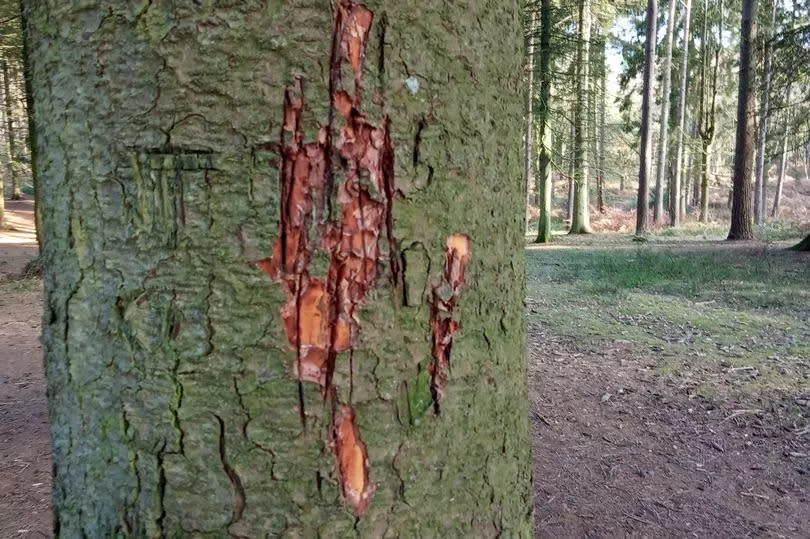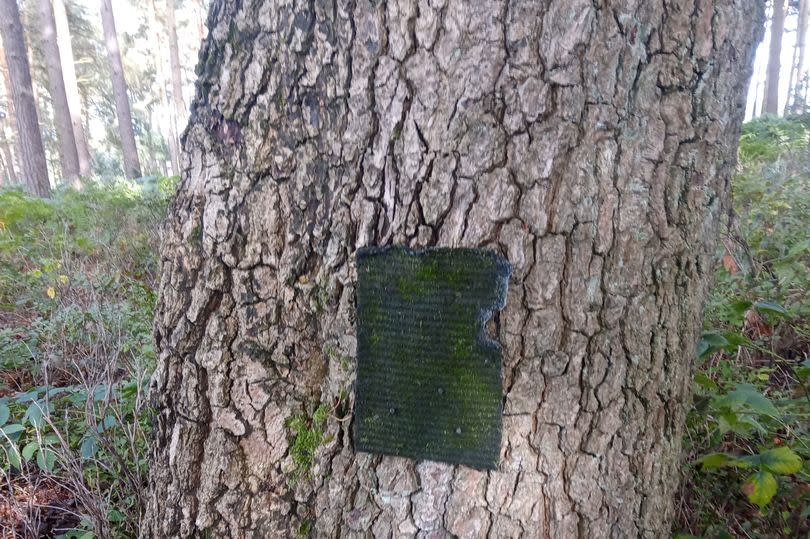What's actually prowling the woods of Cannock Chase?
Situated less than 20 miles north of Birmingham is the picturesque landscape of Cannock Chase, a designated Area of Outstanding Natural Beauty (AONB) spanning 26-square miles with forest and heathland. Many people enjoy walking and mountain biking here - but the expanse of woods is also said to be home to a number of myths and legends.
The forest is well known for allegedly being haunted by a ghost called the Black Eyed Child, which is said to have sprung up on unsuspecting walkers. But another creature that purportedly roams the woods is that of a 'big cat', prompting eyewitness accounts and even some interesting evidence.
Although not native to the UK, there's been reported sightings of a 'brown or sandy coloured' puma or mountain lion in Cannock Chase over the past 20 years. It's believed this animal could have been the offspring of big cats released into the wild during the 1970s, when a five year 'legal loophole' was in place. This so-called big cat earned the nickname the 'Cannock Chase Puma'.
READ MORE: Life next to 'haunted' Midlands forest where people hear 'children crying from within'
Get breaking news on BirminghamLive WhatsApp, click the link to join
But it's just not Cannock Chase where big cats have reportedly been spotted. There's been sightings across the UK in recent decades, often in remote and rural areas. These include the 'Fen Tiger' of Cambridgeshire and the 'Beast of Bodmin Moor' in Cornwall.
At Cannock Chase, foresters and rangers say they've never seen any signs of the elusive creature. Speaking in October last year, Gary Kelsey, Forrest Centre Manger, said: "We have wildlife rangers and foresters out in really quiet parts of the Chase sometimes in the dark, and we've never seen anything of that nature."
However one man who claims to have seen a big cat over Cannock Chase is historian Richard Pursehouse, who recalled witnessing the animal's cat-like "long tail" before it disappeared into a bush. His first encounter took place in 2009 but he claims to have seen it twice.
Speaking in 2021, Mr Pursehouse told BirminghamLive: "It was a puma, a full black puma. It was about 12 years ago. They can live for 30-odd years. The first time I saw it, it was quite a distance away.
"The second time, it was like 'oh, there is that funny looking black Labrador again'. I thought 'it is not - it is a black cat'. There is enough deer over there and a lot were released over Cannock Chase since the 1960s and 1970s. Whether it was off spring or not, but there is plenty for it to eat.
"It crossed in front of me, so I didn't see the head, but it was the tail. It was a dead giveaway. I saw it disappear into the bushes. It had a round tail, all the way down to the floor with a little flick at the bottom. No dog has got a tail with a little flick at the bottom. I was 20 yards away from it. It can survive over there, it has got 3,500 deer (to eat), it can survive on roadkill."
Meanwhile in 2022, a dog-walker called Jan said she'd heard rumours of a 'black panther' over Cannock Chase. Speaking to BirminghamLive, she said a friend claimed they'd 'had a photo of a sheep' which looked like it was killed by a puma-like creature.

Although Mr Pursehouse suspected the 'puma' he witnessed was likely dead by 2021, he came across scratch-like marks on trees over Cannock Chase in 2023. The bark on two trees appeared to have been swiped by a large paw in the old Brindley Village area, creating large etchings in the wood.
And seven months earlier, Mr Pursehouse also found 'scented carpets' nailed to a number of trees, suspecting it was wildlife hunters trying to catch traces of the animal's DNA. He said it was a similar method used by ex-military personnel over Bodmin Moor, in Cornwall, where there has also been a hotspot of sightings.
Danny Bamping, founder of the British Big Cat Society (BBCS) which is based at Dartmoor National Park in Devon, told BirminghamLive that historic reports from Cannock Chase were that of a "mainly brown/sandy coloured puma-type of cat" - which was different in appearance to the "large black cats" typically seen elsewhere in the UK.

He said: "Cannock Chase has had sightings of a puma or mountain lion type cat for well over 20 years and this has been seen by many people. The BBCS has had a lot of big cat sightings reported throughout Staffordshire over the past 25 years."
Elaborating on the Cannock Chase reports, he said: "It is mainly dog walkers (who have seen the 'puma') from what I can recall. People obviously out and about on the Chase, that kind of thing.
"I just remember that, historically, a lot of the sightings were of a puma-type cat, that's why it became known as the 'Cannock Chase Puma', I suppose. It's a bit like the 'Fen Tiger' and the 'Beast of Bodmin Moor' and all that. It just became one of those named cats if you like.
"There was very little in terms of data from other types of cats. The majority of sightings we get up and down the country is of large black cats. But around that area, it just seemed to be a mainly brown/sandy coloured puma-type of cat. For a long time as well, over several years, it was like 'oh, there is the Cannock Chase Puma again'.
"There was one story, I'm not sure if it made the press, but I think there was a family camping out there or on private land near the Chase and they saw it. It was quite interesting because it was three or four of them, it wasn't just one person, there were multiple witnesses."
'Hybrid'
More recent sightings within the general Staffordshire area are that of "large black cats", said Mr Bamping. But he is unsure whether these could be domestic cats, feral cats or even "hybrids".
He said: "More recently, though, some people have reported seeing large black cats which obviously aren’t pumas. We are talking more in Staffordshire rather than just Cannock.
"There has been quite a few black cat sightings in Staffordshire now, so obviously, it isn't just the puma that is being seen, it is other cats as well. When you are looking at what are these black cats, that is the biggest question. Are they hybrids? Are they domestic cats? Are they feral cats? When you look at it from that perspective, they can't be black leopards because where would they have come from."
Asked if a large cat could still be roaming the Cannock Chase area, Mr Bamping said: "Oh yes, without a doubt, absolutely. And also that people are still seeing them. There is obviously something still around. From what I recall, it's not exactly a place where lots of people live."
History of 'big cats' in UK
Across the UK as a whole, Mr Bamping said a lot of big cats were released into the wild from 1976 to 1981 due to a "legal loophole" which allowed their owners to release "non-indigenous species" into the UK. This loophole took place between the passing of the Dangerous Wild Animals Act 1976 and the Countryside Act 1981, he said.
His organisation, the BBCS, believes big cats remain present in the UK and it strives to "identify, catalogue and protect" the creatures, alongside "educating the public" about them. The BBCS even wants to make big cats a "protected species" and "safeguarded from the gun, as far as is reasonably practicable".
It comes as a big cat was confirmed in the British countryside for the first time in May this year after the first DNA evidence was discovered. The DNA was identified from a swab taken from the carcass of sheep in the Lake District, Cumbria, in October 2023.
The animal had been disturbed by a resident whilst it was feeding on a carcass. The eyewitness described the creature as being a "black cat".
DNA analysis revealed the cat had belonged to the Panthera genus - which are the only big cats that can roar. These consist of lions, tigers, leopards and jaguars. However, only two of them can appear black in colour - leopards and jaguars - and scientists said that meant the big cat in the Lake District was either a leopard or jaguar.
Mr Bamping sought to address the terminology around big cats, stating people don't always use the correct name. He said the "scientific definition" of a big cat is those that have the ability to roar, which are lions, tigers, jaguars and leopards.
Scientifically, they are called Panthera, while other larger cats are known as Felis. He added: "Therefore, size wise, a puma is a ‘big cat’ – as are others like cheetahs, lynxes and many others - but scientifically they are not classed as 'big cats'."

 Yahoo News
Yahoo News 
